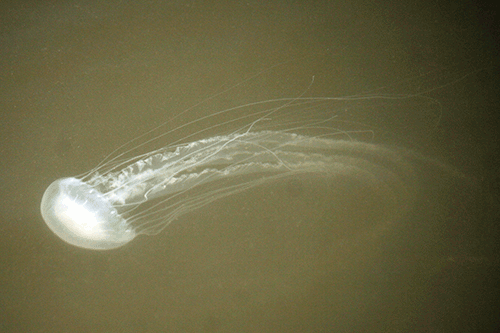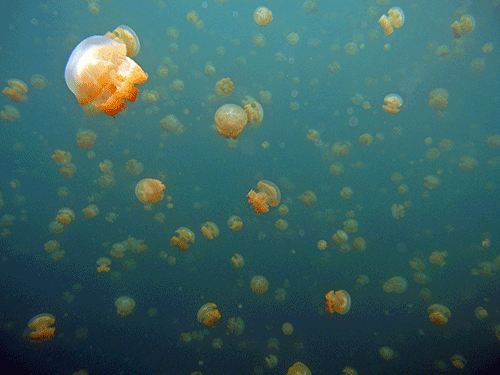Discussing jellyfish with scientific colleagues and Diane Rehm
Bill Dennison ·On 4 June 2013, I joined a panel on the National Public Radio's Diane Rehm Show at the WAMU studio in Washington, D.C. to talk about jellyfish. Diane had Lisa-Ann Gershwin, a jellyfish taxonomist who wrote the book "Stung: On jellyfish blooms and the future of the oceans" on the show. Jack Cover, general curator at the National Aquarium in Baltimore who collects jellyfish from Chesapeake Bay to display in the Aquarium, was also on the panel. I am a jellyfish 'fan', but by no means a jellyfish expert; however Diane wanted someone who knew about Chesapeake Bay, as she had some memorable encounters with the scourge of Chesapeake swimmers - the Atlantic sea nettle (Chrysaora quinquecirrha). In preparation for this panel, I read Lisa's book and talked with Rob Condon who recently led a National Center for Ecological Analysis and Synthesis working group effort to address the question of whether or not jellyfish are increasing globally. Rob directed me to a series of recent papers he and his colleagues had written that provided some good background. In addition, I consulted Dave Nemazie, my University of Maryland Center for Environmental Science colleague who did his Master's degree on Chesapeake Bay jellyfish.

Lisa Gershwin's book included some wonderful anecdotes about various jellyfish blooms including stories of jellyfish clogging ship, power plant and cooling water intakes. It also included some great photos of these magnificent creatures. Jellyfish have no brains, no backbone, no heart, no gills, lots of water and not much organic matter. I recall Larry Madin calling jellyfish "organized water". Lisa is clearly fascinated by these gorgeous, fascinating and sometimes dangerous animals. One of the themes in "Stung" is that there is a worldwide rise of jellyfish resulting from climate change, eutrophication, hypoxia, and overfishing, but this tenet is being challenged by a team of marine ecologists.
Rob Condon and 17 colleagues published a 2012 paper in Bioscience entitled 'Questioning the rise of gelantinous zooplankton in the world's oceans' in which they analyzed all of the jellyfish population data they could find, and concluded that the paradigm of a global rise in jellyfish is unsubstantiated. They noted a lack of good time course data sets and called for a concerted effort to monitor jellyfish. Rob and 21 colleagues followed up with a 2013 Proceeding of the National Academy of Sciences article entitled 'Recurrent jellyfish blooms are a consequence of global oscillations'. In this paper, they describe a 20 year cycle of increasing and then decreasing jellyfish populations. The media tend to portray the 'Rise of Slime' during the increasing phase, and then ignore the decreasing phase. And Carlos Duarte, my seagrass colleague who is also in Rob's jellyfish group, co-authored a 2013 paper 'Is global ocean sprawl a cause of jellyfish blooms?' in Frontiers in Ecology and the Environment in which they advanced the concept of hardened shorelines due to coastal development, which they termed 'ocean sprawl'. Since the life cycle of many jellies includes not only the free floating medusa stage but also an attached polyp phase, and polyps need hard substrates for attachment, the increase in hardened substrates in the coastal ocean could lead to increased jellyfish populations.

In Chesapeake Bay, there is an interesting interplay between the stinging sea nettles (a cnidarian) and the comb jellies, Mnemiopsis leidyi (a ctenophore). Sea nettles are a top predator in the Bay and will eat the comb jellies. Both ingest oyster larvae, but Jenny Purcell determined that the larvae can survive sea nettles, but not comb jellies. Thus, sea nettles, while annoying for swimmers, could benefit oysters. When Jenny was at Horn Point Laboratory, I would ask her how the sea nettles were doing each summer because I enjoyed swimming in the Bay. She would say "It's going to be a great year for nettles!", which I had to reinterpret as "It's going to be a terrible year for swimming!". Jenny, Raliegh Hood, Chris Brown, Tom Gross and Mary Beth Decker teamed up to produce a sea nettle forecasting model, based on the relatively narrow temperature and salinity ranges of sea nettles, which the NOAA Chesapeake Bay Office maintains on their website.

Diane Rehm was fascinated by my nasty encounter with a Portuguese-man-of-war (Physalia physalis), but I also have had some wonderful jellyfish experiences. When I traveled to Palau with Jane Thomas and Ben Longstaff to work with the Palau Conservation Society on a science synthesis and communication project, we visited 'Jellyfish Lake', a stratified marine embayment within a limestone 'Rock Island'. Thousands of beautiful Mastigias papua jellyfish live in this marine lake and make daily migrations within the lake. At night, they sink down to the pycnocline about 50 feet deep to absorb nutrients. In the morning the golden jellies, which contain symbiotic algae (zooxanthellae), swim in a spinning top fashion to the east side of the lake and then track the sun over to the west throughout the day.

I very much enjoyed meeting Diane Rehm. She is a classy and intelligent woman, and her staff were also quite engaging. Investigating the topic of jellyfish stimulated me to read Lisa-Ann Gershwin's interesting book, reconnect with some great colleagues, read some of the latest analyses of jellyfish trends, and reminisce about some good and bad jelly encounters.
About the author
Bill Dennison

Dr. Bill Dennison is a Professor of Marine Science and Vice President for Science Application at the University of Maryland Center for Environmental Science.

